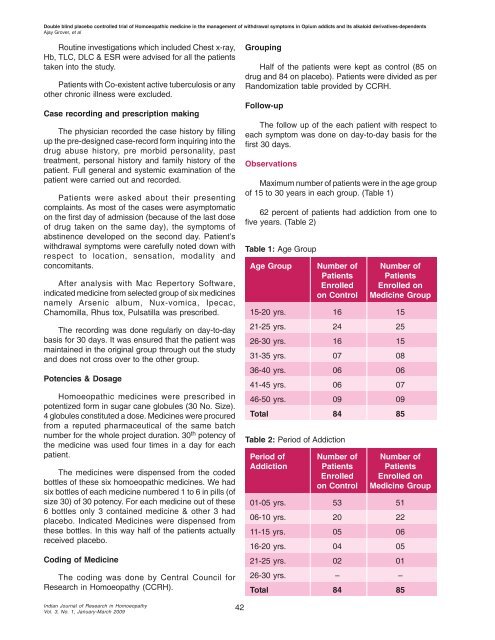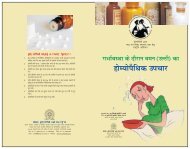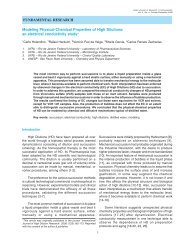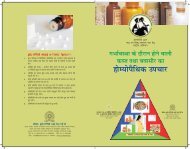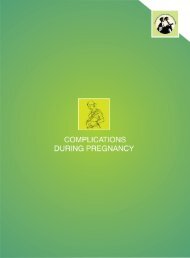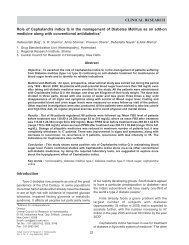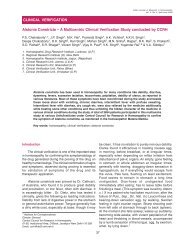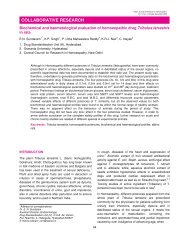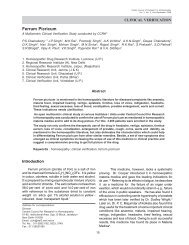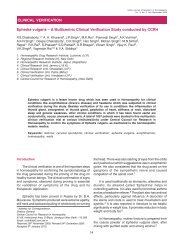Double blind placebo controlled trial of Homoeopathic medicines in ...
Double blind placebo controlled trial of Homoeopathic medicines in ...
Double blind placebo controlled trial of Homoeopathic medicines in ...
You also want an ePaper? Increase the reach of your titles
YUMPU automatically turns print PDFs into web optimized ePapers that Google loves.
<strong>Double</strong> <strong>bl<strong>in</strong>d</strong> <strong>placebo</strong> <strong>controlled</strong> <strong>trial</strong> <strong>of</strong> <strong>Homoeopathic</strong> medic<strong>in</strong>e <strong>in</strong> the management <strong>of</strong> withdrawal symptoms <strong>in</strong> Opium addicts and its alkaloid derivatives-dependents<br />
Ajay Grover, et al<br />
Rout<strong>in</strong>e <strong>in</strong>vestigations which <strong>in</strong>cluded Chest x-ray,<br />
Hb, TLC, DLC & ESR were advised for all the patients<br />
taken <strong>in</strong>to the study.<br />
Patients with Co-existent active tuberculosis or any<br />
other chronic illness were excluded.<br />
Case record<strong>in</strong>g and prescription mak<strong>in</strong>g<br />
The physician recorded the case history by fill<strong>in</strong>g<br />
up the pre-designed case-record form <strong>in</strong>quir<strong>in</strong>g <strong>in</strong>to the<br />
drug abuse history, pre morbid personality, past<br />
treatment, personal history and family history <strong>of</strong> the<br />
patient. Full general and systemic exam<strong>in</strong>ation <strong>of</strong> the<br />
patient were carried out and recorded.<br />
Patients were asked about their present<strong>in</strong>g<br />
compla<strong>in</strong>ts. As most <strong>of</strong> the cases were asymptomatic<br />
on the first day <strong>of</strong> admission (because <strong>of</strong> the last dose<br />
<strong>of</strong> drug taken on the same day), the symptoms <strong>of</strong><br />
abst<strong>in</strong>ence developed on the second day. Patient’s<br />
withdrawal symptoms were carefully noted down with<br />
respect to location, sensation, modality and<br />
concomitants.<br />
After analysis with Mac Repertory S<strong>of</strong>tware,<br />
<strong>in</strong>dicated medic<strong>in</strong>e from selected group <strong>of</strong> six <strong>medic<strong>in</strong>es</strong><br />
namely Arsenic album, Nux-vomica, Ipecac,<br />
Chamomilla, Rhus tox, Pulsatilla was prescribed.<br />
The record<strong>in</strong>g was done regularly on day-to-day<br />
basis for 30 days. It was ensured that the patient was<br />
ma<strong>in</strong>ta<strong>in</strong>ed <strong>in</strong> the orig<strong>in</strong>al group through out the study<br />
and does not cross over to the other group.<br />
Potencies & Dosage<br />
<strong>Homoeopathic</strong> <strong>medic<strong>in</strong>es</strong> were prescribed <strong>in</strong><br />
potentized form <strong>in</strong> sugar cane globules (30 No. Size).<br />
4 globules constituted a dose. Medic<strong>in</strong>es were procured<br />
from a reputed pharmaceutical <strong>of</strong> the same batch<br />
number for the whole project duration. 30 th potency <strong>of</strong><br />
the medic<strong>in</strong>e was used four times <strong>in</strong> a day for each<br />
patient.<br />
The <strong>medic<strong>in</strong>es</strong> were dispensed from the coded<br />
bottles <strong>of</strong> these six homoeopathic <strong>medic<strong>in</strong>es</strong>. We had<br />
six bottles <strong>of</strong> each medic<strong>in</strong>e numbered 1 to 6 <strong>in</strong> pills (<strong>of</strong><br />
size 30) <strong>of</strong> 30 potency. For each medic<strong>in</strong>e out <strong>of</strong> these<br />
6 bottles only 3 conta<strong>in</strong>ed medic<strong>in</strong>e & other 3 had<br />
<strong>placebo</strong>. Indicated Medic<strong>in</strong>es were dispensed from<br />
these bottles. In this way half <strong>of</strong> the patients actually<br />
received <strong>placebo</strong>.<br />
Cod<strong>in</strong>g <strong>of</strong> Medic<strong>in</strong>e<br />
The cod<strong>in</strong>g was done by Central Council for<br />
Research <strong>in</strong> Homoeopathy (CCRH).<br />
Indian Journal <strong>of</strong> Research <strong>in</strong> Homoeopathy<br />
Vol. 3, No. 1, January-March 2009<br />
42<br />
Group<strong>in</strong>g<br />
Half <strong>of</strong> the patients were kept as control (85 on<br />
drug and 84 on <strong>placebo</strong>). Patients were divided as per<br />
Randomization table provided by CCRH.<br />
Follow-up<br />
The follow up <strong>of</strong> the each patient with respect to<br />
each symptom was done on day-to-day basis for the<br />
first 30 days.<br />
Observations<br />
Maximum number <strong>of</strong> patients were <strong>in</strong> the age group<br />
<strong>of</strong> 15 to 30 years <strong>in</strong> each group. (Table 1)<br />
62 percent <strong>of</strong> patients had addiction from one to<br />
five years. (Table 2)<br />
Table 1: Age Group<br />
Age Group Number <strong>of</strong> Number <strong>of</strong><br />
Patients Patients<br />
Enrolled Enrolled on<br />
on Control Medic<strong>in</strong>e Group<br />
15-20 yrs. 16 15<br />
21-25 yrs. 24 25<br />
26-30 yrs. 16 15<br />
31-35 yrs. 07 08<br />
36-40 yrs. 06 06<br />
41-45 yrs. 06 07<br />
46-50 yrs. 09 09<br />
Total 84 85<br />
Table 2: Period <strong>of</strong> Addiction<br />
Period <strong>of</strong> Number <strong>of</strong> Number <strong>of</strong><br />
Addiction Patients Patients<br />
Enrolled Enrolled on<br />
on Control Medic<strong>in</strong>e Group<br />
01-05 yrs. 53 51<br />
06-10 yrs. 20 22<br />
11-15 yrs. 05 06<br />
16-20 yrs. 04 05<br />
21-25 yrs. 02 01<br />
26-30 yrs. – –<br />
Total 84 85


